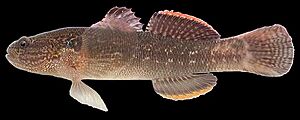Shimofuri goby facts for kids
Quick facts for kids Shimofuri goby |
|
|---|---|
 |
|
| Conservation status | |
| Scientific classification |
The Shimofuri goby (Tridentiger bifasciatus) is a type of fish. It lives in both fresh water and brackish water. Brackish water is a mix of fresh and salt water. This fish is most common in places with low salt levels.
The Shimofuri goby can grow up to 12 centimeters long. It has special features like other goby fish. It has two pelvic fins that join together. These form a suction cup, which helps it stick to things. It also has two dorsal fins on its back. One is spiny, and the other is soft. Its eyes are usually near the top of its head.
Its fins often have orange edges. They usually have 6-7 spines and 11-14 rays. The Shimofuri goby has a flat, wide head. Its color can change a lot. But it is usually light or dark brown. It often has spots along its sides. Tiny white spots can also be seen on its head.
Contents
Where the Shimofuri Goby Lives
The Shimofuri goby naturally lives in Asia. You can find it in fresh and brackish waters there. Its native home includes countries like Japan, Korea, China, and Taiwan. It also lives in parts of Russia.
Shimofuri Goby in California
The Shimofuri goby is now found in the San Francisco estuary. This is in California, USA. By 1990, it had spread south. It reached Pyramid Lake in Los Angeles County. By 2016, this fish was in seven reservoirs in Southern California.
In total, it has been seen in nine places in California. These include Los Angeles and San Diego. It is also in the San Francisco Bay and Suisun Bay. The fish still lives in its native Asian waters too.
How the Shimofuri Goby Arrived
The Shimofuri goby was first found in California in 1985. It was seen in the Suisun Marsh. This marsh is the largest brackish water area on the West Coast. It connects to the San Francisco Bay.
The San Francisco Bay has many international cargo ship ports. Scientists believe this is why many non-native species are found there. The gobies spread from Suisun Marsh. They moved into the Sacramento-San Joaquin Delta. This path led them into the California State Water Project aqueducts by 1993. The gobies have been found in many lakes and reservoirs since then.
How Ballast Water Spreads Species
Scientists think the Shimofuri goby arrived by ballast water. Ballast water is carried in ships. It helps keep large ships stable. Ships use it when they are not carrying heavy cargo.
When cargo is loaded, the ship pumps out this water. This process can release living things into new places. This is how species can travel across oceans. They move to new areas where they would not normally be found.
Why the Shimofuri Goby Thrives
The Shimofuri goby is very tough. It can live in many different conditions. It can handle warm water, up to 37 °C (98.6 °F). It can also tolerate salty water, up to 17 PSU (practical salinity units).
This ability to live in many conditions helps it compete. It can outcompete native fish in the San Francisco Estuary. The Shimofuri goby can also change its diet. It eats what is most available at different times of the year. These traits make the Shimofuri goby a very successful invasive species.
Ecological Role and Threats
The Shimofuri goby mainly eats small creatures. These are called benthic invertebrates. These are tiny animals that live at the bottom of the water. But it also eats other fish, fish eggs, and decaying matter.
The goby likely competes with native fish for food. It is a generalist predator. This means it can eat many different types of prey. It usually eats the prey that is easiest to find. This makes it a strong competitor against local species.
Threat to the Tidewater Goby
The Shimofuri goby is a threat to the native tidewater goby (Eucyclogobius newberryi). Both fish like similar habitats and eat similar foods. They both eat worms, small crustaceans, and other tiny creatures.
The tidewater goby is an endangered species. It is an important part of the estuary food web. If its population shrinks, it affects many other species. Shorebirds, steelhead trout, and other animals eat the tidewater goby. A decrease in tidewater gobies could make these predators also struggle. This shows how one invasive species can harm a whole ecosystem.


